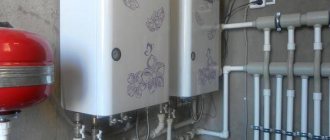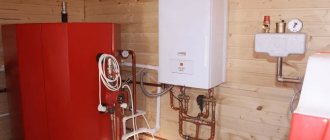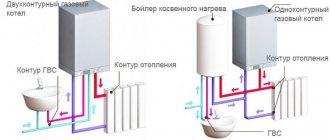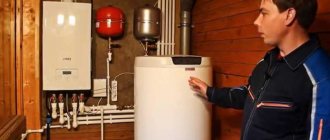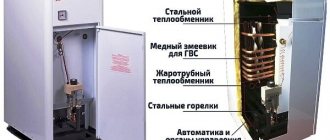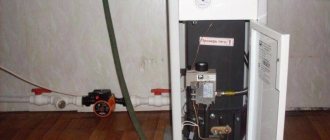Organizing high-quality and efficient heating of a cellar or basement in a country house is not as simple as it seems at first glance. Especially if you want to make the underground room suitable for growing plants or for long-term stay of people. Heating the floors using a heated floor system alone will not help here.
Homeowners often use heaters to increase the air temperature, although they look bulky in the basement and do not always solve the desired problem. A good solution would be to install a heating system in the basement, however, from a technical point of view, this is a significant amount of work.
What technical conditions must be met?
In order for the installation of heating equipment in a basement or basement to remain legal, certain technical conditions must be observed. Read more about them below:
- the number of boilers that will be responsible for heating the house as a whole should not exceed four units;
- the total power of the devices that make up a single heating system should not exceed 200 kW;
- The owner has permission to install a boiler that runs exclusively on natural gas.
Even if all of the above requirements are actually met, it is still too early to start installing a heating source. It is necessary to order a design for the future boiler house from the relevant authorities. This document must be signed and officially approved by the licensed business.
Large gas installation in the basement of a house Source bk.biz.pl
Option for placing equipment in the boiler room of a private house with gas heating Source vodakanazer.ru
Advice from professionals
Before you start building a basement in a building, it is important to know the required stages of the process, which will be useful both when ordering construction from craftsmen, and when doing the work yourself.
To ensure that the building structure from the basement to the roof is strong and reliable, the following steps must be followed:
- Soil analysis, you need to know its characteristics and groundwater content.
- Planning, it is necessary to prepare design documentation in accordance with construction norms and standards.
- Preparing the area, draining in case of high humidity, digging a pit.
- The construction of the basement is carried out using high-quality building materials, observing technical standards.
- The final stage of work includes finishing the walls, installing wiring, ventilation, and heating as necessary.
Building a basement in a house is not an easy process, which involves a lot of work, so that everything is of high quality and reliable, it is better to turn to a specialized construction company with experience for help.
Requirements for the premises in which a gas boiler room will be installed
Assuming that the conditions from the section above have already been met, you still cannot start the system until you are sure that the premises meet the following requirements:
- Sufficient ceiling height. The optimal distance from the floor to the ceiling is 2.2-2.5 meters. But it is better to start from the maximum point.
- The basement should not border on living rooms. That is, if the basement is located under a corridor or kitchen, then installing a gas boiler is acceptable. If this is a living room, bedroom or recreation room, then it is better to refuse installation of heating equipment.
- Login parameters have been met. It is necessary that the organization of the entrance to the basement is carried out correctly. The optimal width of the opening is at least 80 cm, and when installing the door leaf, you should refuse to install a threshold (that is, a fairly wide gap should form under the door. It is also better to additionally leave several convection holes in the door leaf.
- Maintain the distance between the wall and the boiler. In this case, there must be at least 1 m from the partition to the rear wall of the unit. This applies even if the smoke duct is installed through the wall.
- The presence of forced exhaust. It promotes spontaneous weathering of gases and explosive substances from the room. In cold weather, do not cover such openings with rags and insulation. They must work all year round. Once a year, when performing maintenance, the performance of the hood must be checked by specialists.
- Application for finishing non-combustible materials. Decorative wallpaper, polystyrene foam, laminate, wood, plastic - all this is prohibited from being used for surface finishing in a gas boiler room. Preference should be given to tiles, plaster, and concrete screed.
- The presence of a window opening is required. Moreover, the frame parameters should be selected based on 0.03 m2 for every 1 m3. It is important that the opening faces the street and that the window opens. Please note: if the window in the room is less than ¼ per 1 m2, then this room is not suitable for a boiler room. The distance from the window to the boiler is also taken into account: at least 1.5 meters.
- Availability of protective shields in the premises. These are necessary to protect surrounding objects from fire. Ideally, it is better to get rid of them altogether.
- Ease of maintenance and operation. From time to time, gas equipment needs to be checked for serviceability. In order to conveniently carry out maintenance (maintenance) of the device, it is necessary to provide access to it from all sides, and this is at least 1 meter.
On a note! It is better not to install the atmospheric type of gas boiler in the basement. It is advisable to place heating equipment with an internal combustion chamber here.
Normal distance from the wall to the boiler in a boiler room in the basement Source thebauernhaus.blogspot.com
Boiler types
There are different heater designs made for different heat sources or fuel types.
The choice of type is determined by the availability of a certain type of energy or fuel. If there are several options, the most economical option is usually used.
The most common types of heaters are:
- Indirect. The transfer of thermal energy between different media is used.
- Flow-through. The pipe section heats up. Efficiency depends on the flow rate: the higher it is, the less efficient the heater is - the liquid does not have time to heat up to the required temperature. At the same time, you can use such a device immediately, without waiting for the required volume to heat up, and the hot water will never run out.
- Cumulative. Heating a liquid in a container of a certain volume. You can create any pressure - the temperature will not change. But when the tank is empty, you will have to wait for the new volume to heat up, which takes some time.
Depending on the type of heater, the devices are:
Let's take a closer look at them.
Indirect water heaters
Indirect heating is used in heat exchangers. The principle of its operation is to transfer thermal energy from one medium to another without mixing. The design of an indirect type boiler most often consists of a container into which cold water is supplied. It is located inside another larger container through which hot coolant is passed. The cold liquid absorbs the energy of the coolant and heats up.
The flow rate of the coolant is adjusted so that it does not cool down too much and is suitable for heating rooms.
Instantaneous electric water heaters
Instantaneous water heaters are devices in which a section of pipe with water passing through it is heated . In order for the temperature to rise to a normal value during the flow of liquid through a relatively small area, a sufficiently powerful heater is required. It needs the appropriate network and wiring. This point is the weakest point of electric heaters, since not everywhere it is possible to install a powerful device without the risk of destroying the power line.
In addition, with high water consumption, it simply does not have time to heat up. This option is good when space is limited, since instantaneous water heaters are compact in size and can be installed in small rooms.
Instantaneous gas water heaters
Gas water heaters are commonly referred to as “gas water heaters”. They are more efficient than electric ones and do not require large expenses. The dimensions of such devices are very compact, which also speaks in favor of gas equipment.
Rules for installing a heating boiler
A gas boiler in the basement is organized taking into account special requirements. These data are taken from SNiP:
- For basements, the installation of closed type equipment is strictly recommended. Its peculiarity is that the device independently captures air from the street to improve ignition;
- if it is necessary to hang the boiler, then take into account that the distance from the floor should not exceed 80-160 cm, while it is important that there is a gap of 1 meter or more to the ceiling.
From year to year, the requirements in SNiP may change and be adjusted; There are also those that completely lose their power. Therefore, in order to know exactly about the regulatory requirements, it is better to consult a heating engineer with an existing heating engineer.
Installation of a gas boiler in the basement of a house on a concrete pad Source sense-life.com
What is the optimal cellar temperature for storing vegetables?
The “step” at which it is best to store vegetables in the basement is quite large, from 0 degrees to + 7, + 7 is on hot summer days.
Vegetables, of course, are also different, some may be tropical, but they generally cannot tolerate even 0 temperatures.
When it comes to the temperature in the cellar, it is best to focus on ordinary household refrigerators; the temperature in the compartments for storing vegetables there is around + 5 degrees.
Unlike cellars, refrigerator manufacturers conducted research, thanks to which the most favorable temperature was found for different compartments of the refrigerator (I’m talking about modern models).
It is best to control the temperature in the cellar using thermometers; it is better to take an alcohol wall thermometer,
When the outside temperature drops sharply (for example, below 30), it is necessary to pay especially close attention to the temperature in the cellar, including heating; temperatures below 0 are detrimental to many vegetables.
Requirements for how to organize a chimney in a room
The chimney for a gas boiler in the basement or basement must also be arranged in accordance with the requirements. The following must be taken into account:
- the smoke exhaust pipe should not pass through living rooms;
- The “neck” of the chimney must not be covered with decorative objects in order to hide the unaesthetic appearance;
- the number of chimneys must be equal to the number of installed gas boilers. It is impossible for combustion products from several gas units to be discharged through one system;
- the chimney must be organized separately, and not use a pre-prepared ventilation shaft for it.
Chimney pipe for a heating device installed in the basement Source drive2.com
The most optimal method of smoke removal is along the outer wall of the building, since this method is the simplest. For boilers with an internal combustion chamber, a vertical type coaxial chimney is installed.
Approximate diagram of the organization of a chimney for a gas boiler in the basement Source rosstin.ru
Relationship with other communications
In order for the boiler room in the basement to function well, it is necessary that all necessary communications be organized in it. Therefore, the room in which the heating equipment will be installed must meet a number of conditions:
- When installing a single-phase electrical circuit, be sure to pay attention to the voltage. Its values should be minimal (220 Volts), and as for the current strength, it should reach no more than 20 Amperes. It also requires the mandatory installation of grounding and a circuit breaker in the event of a short circuit;
- If one boiler is installed in the boiler room, there must be one locking mechanism. If several units are installed, the number of shut-off valves should be similar;
- the water supply in the room where heating is installed must be part of a single water supply system that is present in the house. Also in the same room there should be a valve and a pipe through which the system will be powered before the heating season;
- objects such as water supply, chimney, ventilation shaft, located in the basement, need protection from condensation. Therefore, you will also have to organize the removal of excess moisture;
- presence of gas detection sensors. Ideally, it will be a signaling device model with a shut-off valve included in the kit.
Gas or electricity
It is recommended to use a network voltage in the basement no higher than 42 V.
So, an important factor in determining which basement heating you choose will be the purpose of the room. If you plan to equip a living space in the basement, you will need full heating so that it is warm even in the most terrible frosts. Options for steam heating and a gas boiler will be relevant here, if the design provides for this. If the ventilation of the basement is poor, then first you need to finish it, plastering all the cracks where outside air can come from.
If you are planning an office space or a store, you can choose a heating system based on radiators that operate from the electrical network and are capable of heating rooms with a fairly large area. Such heating in the basement will also dry the air, so it is ideal for rooms with high humidity.
But with this choice of heating, it is worth paying attention to the power of the electrical network where the radiator will be connected. If an office is heated, where there are already a lot of electrical appliances and electronics, the network will not be able to withstand such voltage and there will be a need to install additional equipment, which will incur certain costs in addition to paying for electricity
If the humidity in the basement exceeds acceptable standards, then in addition to heating, you should also worry about drying the air, since moisture destroys the basement as a whole and negatively affects the quality of the air you will breathe. This way you can create comfortable conditions on the ground floor.
If you plan to store something in the basement, use it as a warehouse, and the relatively low temperature will not interfere with storage, you can use an ordinary battery, and installing it will not require any special changes in the heating design throughout the house.
Infrared heating is an alternative to boilers and batteries. This option has several advantages: short installation work, ease of installation of equipment. It can be arranged quickly, conveniently, simply and efficiently.
In any case, when installing any heating, consultation with certain responsible services is first necessary. You can only install a heater in the basement yourself; in all other cases, you will need the help of specialists, professionals in their field. Calculations that will be associated with installing heating in the basement are also best left to professionals.
The issue of material for equipment is also important. What material is best to choose the pipes that will be installed, what batteries are best to choose, or what type of radiator will be of better quality? All these are individual parameters for each specific basement, and only correct calculations and observations of air and humidity can show this.
Peter Kravets
Reading time: 4 minutes
A A
Basement heating is of interest to both owners of multi-storey buildings and private country cottages. They are often equipped with bars, billiard rooms, cafes, recreation areas, gyms, saunas or small cinemas.
How to install a wall-mounted gas boiler in the basement
Often, when installing a boiler room in the basement, they try to use wall-mounted units as the basis for the equipment, despite the fact that they differ in labor costs. The main condition that installation must meet is reliable fastening of the equipment.
When trying to install a gas boiler, it is necessary to take into account nearby structures. The distance from the boiler to a nearby object (pipes, other structures) must be at least 20 cm.
When installing to a wall, it is necessary to leave about 2-3 cm from it. Also, according to the standards, it is allowed to install a gas boiler above other equipment, the main thing is that the requirements for the distance from the ceiling surface are met (as mentioned above - at least 1 meter).
Installation of a wall-mounted gas boiler in the basement of your own house Source terman-s.ru
The installation must begin from the preparatory stage. The necessary tools, fastening elements, and other components are assembled. The installation can be entrusted to specialists or follow the instructions that come with the gas equipment.
On a note! There must be a plate on the gas boiler that specifies the technical characteristics. Before installing the unit, you need to make sure that the instructions contain exactly the same data.
It is possible that the partition in the basement will be covered with wood. If you have to mount gas equipment on it, then you must first cover such a wall with fireproof material. The minimum thickness of such insulation is 3 mm.
Wall-mounted gas boiler in the basement on a brick wall Source terman-s.ru
Next, proceed to installing the brackets. For them, grooves are prepared, and then hook-shaped fasteners are screwed into the holes or driven in (if they are anchor dowels). Any wall-mounted equipment is supplied with mounting strips and clamps, as well as a mounting diagram. In order for the gas boiler to rest securely on the wall, you must act strictly according to the diagram.
Having hung and slightly secured all the fasteners, you should check whether the heating device is in a horizontal position. Its performance depends on this. Due to the out-of-level installation, there is a risk that the wick will go out from time to time when air from the street enters the pipe.
Important! Since during transportation of the boiler the pipes through which the coolant will pass become clogged, they must be cleaned. It is better to do this under water pressure (for example, from a Karcher, but the main thing is not to overdo it). As for the water input, a fitting with a filter and a shut-off valve must be installed on the pipe. It will prevent large particles of dirt from entering the system.
Checking pipes before installing a gas boiler Source gazservis72.ru
Installation of this type of equipment requires professionalism. Even if you can install the device yourself, you will have to hire gas service specialists to connect it, but the boiler room in the basement must comply with the standards.
Organization of thermal protection at home
In places where heating will be done in the basement of a private house, it is necessary to insulate the external walls, especially the parts that will be in direct contact with the ground. This will help keep the heat inside and prevent condensation from forming.
In basements without heating, insulation with heat-protective materials is done, as for a heated one, only additional layers can be added to the ceiling of the room to prevent the cold from penetrating into the upper floors.
With external thermal insulation, the basement receives the following advantages:
- There are no cold bridges through which wind and frosty air enters the room;
- When condensation forms, it does not have time to cause a destructive effect on materials and the room;
- The useful space inside the basement does not become smaller;
- It is convenient to inspect structures, which allows you to quickly notice their damage by fungus or mold, as well as defects due to damage from insects and rodents.
Among the disadvantages it is necessary to note:
- It is necessary to protect the layers of thermal insulation from mechanical damage for the entire period of use of the house, with the cost of protective devices being significantly greater than the layers of thermal insulating material themselves;
- It is difficult to protect against damage from insects; disinfestation is done using poisons and other toxic substances, which is not always applicable in a residential building;
- When facing with brick, cold can penetrate, which will reduce the heat level in the room.
Even when designing the structure, protective work is planned against the following factors:
- Exposure to groundwater, which, if it gets into the basement, is difficult to dry, especially in terms of enclosing structures;
- When pouring, moisture in the concrete mixture enters the room for a long time, giving dampness and a musty smell;
- Capillary rise of water from different sources through capillaries in the materials from which the basement was built is possible;
- The air in the room also forms moisture through condensation; the inner layer of thermal insulation is not capable of ensuring absolute tightness, so condensation may appear on the walls of the base. It is also formed from gases from the soil, which can penetrate the entire perimeter of the basement;
- For internal insulation of a room, materials are often used whose level of water penetration is quite high, and when wet their characteristics are reduced. Then it is necessary to protect them with individual waterproofing work;
- Internal thermal insulation layers create difficulties when draining the basement. Moisture from soil, concrete and capillary water from base materials are very difficult to remove and require long-term drying. It is required to make high-quality waterproofing;
- The walls that are below ground level are cold, and the warm and humid air of the basement somehow affects them from the inside, which leads to the formation of moisture with subsequent destruction of materials.
When equipping a structure that protects from damage, additional layers of thermal protection can be made, both outside and inside. But they have the same disadvantages as the base, only at the same time they increase the estimate several times.
Features of installation of floor structures
This process also requires several steps:
- Preparation of tools and equipment.
- Arrangement of a special foundation cushion or support frame.
- Organization of a chimney, water supply.
- Inspection of the ventilation shaft or its installation (if there was no system previously).
- Direct installation of equipment.
In general, there is nothing complicated, but after installation you need to make sure that the gas boiler is parallel to the floor. If it has adjustable legs, then adjusting the installation position will not be difficult.
Only after you have achieved the ideal level can you begin to install the filter on the inlet water supply and connect the chimney pipe directly to the organized channel. All connections must be treated with sealant. In the case of a chimney, you will have to give preference to an option that can withstand heat.
Correct location of the gas boiler on the floor in the basement Source ef-tehno.ru
Do I need to heat the basement floor?
Everything about water supply and sewerage
Pumping stations and wastewater treatment plants
Sewer
Plumbing
Firefighters
The Admiral plant produces complete pumping stations for water supply, fire fighting and sewerage needs. Admiral plant website: admiral-omsk.ru
Ventilation arrangement: important points
The best option is natural ventilation. It is most often organized in the ceiling area. If this is not possible, then they do it in the wall, directly under the ceiling. It is noted that for high-quality ventilation of a room with installed equipment with a power of 1 kW, 8 cm2 of inflow is sufficient.
It happens that it is difficult to organize ventilation from the street, so air is taken from the adjacent room. In this case, a boiler with a power of 1 kW will require up to 30 m2 of inflow.
Sometimes natural ventilation cannot be realized. In this case, they resort to artificial methods, for example, installing a fan, which is connected to electricity. They also use duct installations. It is necessary to select mechanical devices according to power, which is pre-calculated according to this principle: the width and height of the room are multiplied by the length.
Forced ventilation in the basement where heating is installed Source drive2.ru
The most efficient ventilation units are those with an aluminum or copper casing. These materials are known to resist melting.
Expansion tank requirements
From the point of view of current standards, an expansion tank must have been organized in a gas autonomous heating system. The installation of such a design is necessary to compensate for the missing amount of water taken from the water supply when starting to power the system.
An expansion tank is also necessary to relieve the resulting water pressure during heating. Additionally, a device can be inserted, which will be responsible for feeding the main heating circuit.
On a note! The current SNiP allows the use of polypropylene pipes with aluminum reinforcement for soldering the heating system. It is important that the use of such material meets two conditions: withstand pressure up to 3 bar and a coolant temperature of 105 degrees.
Method 1 – one-pipe
Construction of a deep cellar. This option is quite rare, because a person will not be able to stay in a room with such a system for a long time. This system is ideal for maintaining fresh air and temperature within normal limits, because... The process itself is quite slow, i.e. When major changes occur outside the room, the system reacts very slowly. This is very useful when you need to maintain temperature in very hot or extremely cold environments. The only disadvantage is the inability of a living creature to stay indoors for a long time, because... The supply of oxygen decreases very quickly.
Advantages and disadvantages of a gas boiler in the basement
Placing a gas boiler room in the basement is justified by many positive features. Let's define worthy qualities:
- convenient organization of space (if the boiler is placed in the basement, it will not take up free centimeters in rooms such as the kitchen or pantry);
- The design is not spoiled by oversized heating installations. Typically, gas boilers look oversized, which is not entirely appropriate for the chosen interior.
There are also negative qualities:
- There are cases when gas utilities use outdated SNiP, which prohibit the installation of a boiler room in the basement;
- major construction work is required in order to create a sufficient width of window and door openings;
- It is imperative to use fire-resistant raw materials, since the basement becomes flammable.
Gas heating pipes that take up a lot of space Source master-vodoved.ru
As repeated practice shows, bans on installing a gas boiler room in the basement apply to private households with permanent residence. Based on this, we recommend that you do not rush to complete the installation until the official appeal to the supervisory authorities receives a response.
Cost-effectiveness and autonomy: which boiler is better to choose taking into account these characteristics
Installing heating equipment in the basement is also permissible if the source is not blue fuel, but another type, for example, solid raw materials. Here you will have to decide which option is ideal for this purpose. When choosing, you need to focus on autonomy and efficiency.
The concept of autonomy means minimal participation of the owner in the process of connecting the heating. If you need complete independence from humans, then it is better to give preference to electric boilers.
Correct installation of gas equipment in the basement for servicing Source tesystems.ru
Regarding efficiency, it is necessary to pay tribute to the equipment, the source of which is main gas. This fuel is considered the cheapest. As of April 2021, one cubic meter of gas costs 5 rubles 56 kopecks (this is data for the Republic of Crimea).






